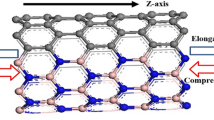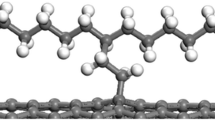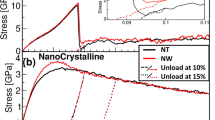Abstract
Atomic defects can be generated relatively easily in phosphorene due to their low formation energies. How these defects affect the buckling behavior of phosphorene nanotubes (PNTs) remains unexplored. Using molecular dynamics simulations, we investigate the effect of vacancies on the buckling properties of PNTs. We show that compared to a pristine PNT, the defective one exhibits a much lower buckling strength and strain. Remarkably, 1% concentration of vacancies in a PNT is able to cause a 30% reduction in buckling strength. Interestingly, for long PNTs, the buckling occurs via column or global buckling. As a result, the buckling strength decreases significantly with the increase (decrease) in the tube length (diameter) for both the pristine and defective PNTs, consistent with the Euler buckling theory. For short PNTs with small slenderness ratio (L/D), however, buckling occurs via shell or local buckling. As a result, the buckling strength increases with decreasing the tube diameter, consistent with shell buckling theory. Finally, with the increase in temperature, the buckling strength and strain can be reduced significantly for both the pristine and defective PNTs. These findings may provide important guidelines for the design and applications of PNTs-based nanodevices.





Similar content being viewed by others
References
Novoselov KS, Geim AK, Morozov SV, Jiang D, Zhang Y, Dubonos SV, Grigorieva IV, Firsov AA (2004) Electric field effect in atomically thin carbon films. Science 306:666–669
Novoselov KS, Fal’ko VI, Colombo L, Gellert PR, Schwab MG, Kim K (2012) A roadmap for graphene. Nature 490:192–200
Georgakilas V, Tiwari JN, Kemp KC, Perman JA, Bourlinos AB, Kim KS, Zboril R (2016) Noncovalent functionalization of graphene and graphene oxide for energy materials, biosensing, catalytic, and biomedical applications. Chem Rev 116:5464–5519
Heerema SJ, Dekker C (2016) Graphene nanodevices for DNA sequencing. Nat Nanotechnol 11:127–136
Pei QX, Zhang YW, Shenoy VB (2010) A molecular dynamics study of the mechanical properties of hydrogen functionalized graphene. Carbon 48:898–904
Jiao SP, Duan CH, Xu ZP (2017) Structures and thermodynamics of water encapsulated by graphene. Sci Rep 7:2646
Xu ZP, Buehler MJ (2010) Geometry controls conformation of graphene sheets: membranes, ribbons, and scrolls. ACS Nano 4:3869–3876
Li L, Yu Y, Ye GJ, Ge Q, Ou X, Wu H, Feng D, Chen XH, Zhang YB (2014) Black phosphorus field-effect transistors. Nat Nanotechnol 9:372–377
Fei R, Yang L (2014) Strain-engineering the anisotropic electrical conductance of few-layer black phosphorus. Nano Lett 14:2884–2889
Liu H, Neal AT, Zhu Z, Luo Z, Xu X, Tomanek D, Ye PD (2014) Phosphorene: an unexplored 2D semiconductor with a high hole mobility. ACS Nano 8:4033–4041
Buscema M, Groenendijk DJ, Blanter SI, Steele GA, van der Zant HSJ, Castellanos-Gomez A (2014) Fast and broadband photoresponse of few-layer black phosphorus field-effect transistors. Nano Lett 14:3347–3352
Qiao J, Kong X, Hu ZX, Yang F, Ji W (2014) High-mobility transport anisotropy and linear dichroism in few-layer black phosphorus. Nat Commun 5:4475
Xia F, Wang H, Jia Y (2014) Rediscovering black phosphorus as an anisotropic layered material for optoelectronics and electronics. Nat Commun 5:4458
Castellanos-Gomez A (2015) Black phosphorus: narrow gap, wide applications. J Phys Chem Lett 6:4280–4291
Ren XL, Lian PC, Xie DL, Yang Y, Mei Y, Huang XR, Wang ZR, Yin XT (2017) Properties, preparation and application of black phosphorus/phosphorene for energy storage: a review. J Mater Sci 52:10364–10386. https://doi.org/10.1007/s10853-017-1194-3
Zhang YY, Pei QX, Jiang JW, Wei N, Zhang YW (2016) Thermal conductivities of single- and multi-layer phosphorene: a molecular dynamics study. Nanoscale 8:483–491
Qin G, Yan QB, Qin Z, Yue SY, Hu M, Su G (2015) Anisotropic intrinsic lattice thermal conductivity of phosphorene from first principles. Phys Chem Chem Phys 17:4854–4858
Liu B, Bai LC, Korznikova EA, Dmitriev SV, Law AWK, Zhou K (2017) Thermal conductivity and tensile response of phosphorene nanosheets with vacancy defects. J Phys Chem C 121:13876–13887
Pei QX, Zhang X, Ding Z, Zhang YY, Zhang YW (2017) Thermal stability and thermal conductivity of phosphorene in phosphorene/graphene van der Waals heterostructures. Phys Chem Chem Phys 19:17180–17186
Jiang JW, Park HS (2014) Mechanical properties of single-layer black phosphorus. J Phys D Appl Phys 47:385304
Sha ZD, Pei QX, Ding ZW, Jiang JW, Zhang YW (2015) Mechanical properties and fracture behavior of single-layer phosphorene at finite temperatures. J Phys D Appl Phys 48:395303
Yang Z, Zhao J, Wei N (2015) Temperature-dependent mechanical properties of monolayer black phosphorus by molecular dynamics simulations. Appl Phys Lett 107:023107
Liu N, Hong JW, Pidaparti R, Wang XQ (2016) Fracture patterns and the energy release rate of phosphorene. Nanoscale 8:5728–5736
Wei Q, Peng X (2014) Superior mechanical flexibility of phosphorene and few-layer black phosphorus. Appl Phys Lett 104:251915
Li L, Feng C, Yang J (2017) Tensile and compressive behaviors of prestrained single-layer black phosphorus: a molecular dynamics study. Nanoscale 9:3609–3619
Jiang JW, Park HS (2014) Negative Poisson’s ratio in single-layer black phosphorus. Nat Commun 5:4727
Du YC, Maassen J, Wu WR, Luo Z, Xu XF, Ye PD (2016) Auxetic black phosphorus: a 2D material with negative Poisson’s ratio. Nano Lett 16:6701–6708
Treacy MMJ, Ebbesen TW, Gibson JM (1996) Exceptionally high Young’s modulus observed for individual carbon nanotubes. Nature 381:678–680
Liew KM, Wong CH, He XQ, Tan MJ, Meguid SA (2004) Nanomechanics of single and multiwalled carbon nanotubes. Phys Rev B 69:115429
Seifert G, Hernandez E (2000) Theoretical prediction of phosphorus nanotubes. Chem Phys Lett 318:355–360
Cabria I, Mintmire JW (2004) Stability and electronic structure of phosphorus nanotubes. Europhys Lett 65:82–88
Guo H, Lu N, Dai J, Wu X, Zeng XC (2014) Phosphorene nanoribbons, phosphorus nanotubes, and van der Waals multilayers. J Phys Chem C 118:14051–14059
Liao X, Hao F, Xiao H, Chen X (2016) Effects of intrinsic strain on the structural stability and mechanical properties of phosphorene nanotubes. Nanotechnology 27:215701
Cai K, Wan J, Wei N, Cai H, Qin QH (2016) Thermal stability of a free nanotube from single-layer black phosphorus. Nanotechnology 27:35703
Cai K, Wan J, Wei N, Qin QH (2016) Strength and stability analysis of a single-walled black phosphorus tube under axial compression. Nanotechnology 27:275701
Yu S, Zhu H, Eshun K, Arab A, Badwan A, Li Q (2015) A computational study of the electronic properties of one-dimensional armchair phosphorene nanotubes. J Appl Phys 118:164306
Banhart F, Kotakoski J, Krasheninnikov AV (2011) Structural defects in graphene. ACS Nano 5:26–41
Gao JF, Zhang JF, Liu HS, Zhang QF, Zhao JJ (2013) Structures, mobilities, electronic and magnetic properties of point defects in silicene. Nanoscale 5:9785–9792
Hu W, Yang J (2015) Defects in phosphorene. J Phys Chem C 119:20474–20480
Ding ZW, Pei QX, Jiang JW, Zhang YW (2015) Manipulating the thermal conductivity of monolayer MoS2 via lattice defect and strain engineering. J Phys Chem C 119:16358–16365
Ng TY, Yeo JJ, Liu ZS (2012) A molecular dynamics study of the thermal conductivity of graphene nanoribbons containing dispersed Stone–Thrower–Wales defects. Carbon 50:4887–4893
Sha ZD, Pei QX, Zhang YY, Zhang YW (2016) Atomic vacancies significantly degrade the mechanical properties of phosphorene. Nanotechnology 27:315704
Wang S, Qin Z, Jung GS, Martin-Martinez FJ, Zhang K, Buehler MJ, Warner JH (2016) Atomically sharp crack tips in monolayer MoS2 and their enhanced toughness by vacancy defects. ACS Nano 10:9831–9839
Ansari R, Motevalli B, Montazeri A, Ajori S (2011) Fracture analysis of monolayer graphene sheets with double vacancy defects via MD simulation. Solid State Commun 151:1141–1146
Zhan H, Zhang Y, Bell JM, Gu Y (2015) Suppressed thermal conductivity of bilayer graphene with vacancy-initiated linkages. J Phys Chem C 119:1748–1752
Babar R, Kabir M (2016) Transition metal and vacancy defect complexes in phosphorene: a spintronic perspective. J Phys Chem C 120:14991–15000
Chen WH, Chen IC, Cheng HC, Yu CF (2017) Influence of structural defect on thermal-mechanical properties of phosphorene sheets. J Mater Sci 52:3225–3232. https://doi.org/10.1007/s10853-016-0611-3
Liu P, Pei QX, Huang W, Zhang YW (2017) Mechanical properties and fracture behaviour of defective phosphorene nanotubes under uniaxial tension. J Phys D Appl Phys 50:485303
Plimpton S (1995) Fast parallel algorithms for short-range molecular-dynamics. J Comput Phys 117:1–19
Jiang JW (2015) Parametrization of Stillinger–Weber potential based on valence force field model: application to single-layer MoS2 and black phosphorus. Nanotechnology 26:315706
Diao JK, Gall K, Dunn ML (2004) Atomistic simulation of the structure and elastic properties of gold nanowires. J Mech Phys Solids 52:1935–1962
Komsa HP, Kotakoski J, Kurasch S, Lehtinen O, Kaiser U, Krasheninnikov AV (2012) Two-dimensional transition metal dichalcogenides under electron Irradiation: Defect production and doping. Phys Rev Lett 109:035503
Zhang YY, Xiang Y, Wang CM (2009) Buckling of defective carbon nanotubes. J Appl Phys 106:113503
Shokuhfar A, Ebrahimi-Nejad S (2013) Effects of structural defects on the compressive buckling of boron nitride nanotubes. Phys E 48:53–60
Timoshenko SP, Gere JM (2012) Theory of elastic stability. Courier Corporation, North Chelmsford
Acknowledgements
This work was partially supported by a grant from the Science and Engineering Research Council, A*STAR, Singapore (152-70-00017). The authors gratefully acknowledge the computational support provided by A*STAR Computational Resource Centre of Singapore.
Author information
Authors and Affiliations
Corresponding authors
Ethics declarations
Conflict of interest
The authors declare that there is no conflict of interest regarding the publication of this article.
Rights and permissions
About this article
Cite this article
Liu, P., Pei, QX., Huang, W. et al. Strength and buckling behavior of defective phosphorene nanotubes under axial compression. J Mater Sci 53, 8355–8363 (2018). https://doi.org/10.1007/s10853-018-2152-4
Received:
Accepted:
Published:
Issue Date:
DOI: https://doi.org/10.1007/s10853-018-2152-4




